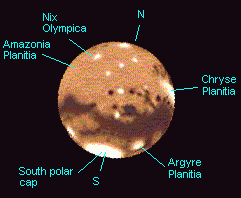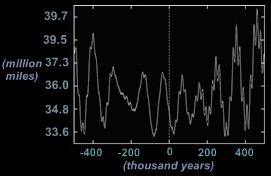
- - text and links as of last publication - -

Mars was at its nearest from Earth (34.65 million miles) since 73,000 years on August, 27th at 10h TU. This close encounter is the closest since between 50,000 and 73,000 years. Mars will be at its opposition. Opposition is a peculiar location of a planet on its orbit relative to Earth and Sun: both planets are on the same side of the Sun, in line (for more about opposition, see "Apparent motion of planet"). Oppositions of Mars occurs every 26 months. But this will be a peculiar opposition, as it is a perihelic one: as the same time Mars is at is nearest to the Earth, it is, on its orbit, at its nearest of the Sun (its so-called perihelion; strictly speaking this takes place this year on August, 30th). Such peculiar oppositions take place only every 15 to 17 years. And, even in this peculiar frame, Mars will be at its nearest since this long period of time. As at its last perihelic oppositions (1971, 1988), Mars displayed a disk of respectively 24.9 and 23.8" , the red planet, this summer will be 25.15" wide. So, watch! The show is clearly remarkable. Mars, next summer, will be brighter than Jupiter at its brightest (it will reach -2.9 magnitude) and will be outdone only by Venus, and Mars will shine remarkably red. It is said that one may see at most five perihelic oppositions in a lifetime, and this one is the nearest since about 50,000-70,000 years
 | At the exact time of the perihelic opposition, Mars will display this figure. Syrtis Major, one of the most famous martian feature is invisible, far behind the western limb of the planet courtesy Mars Previewer II by Leandro Ríos |
Such closenesses are going to become relatively frequent in the future as, based on the progressive shift of both Earth and Mars' orbits and on Mars orbit's Jupiter-tugged elongation (the orbit is getting elongated, perihelion getting closer, aphelion farther), aphelion and Mars' perihelion are aligning together on a long-run movement, and will afterwards grow distant, in the same long run movement (aphelion is the point of the Earth's orbit where our planet is farthest from the Sun; it will so be near to the Mars' perihelion -point of an orbit closest to the Sun); so, between now and the year 3,000, there will be 7 perihelic oppositions (the closest being the one of 2729, at 34,580,000 miles; other reliable source gives the year 2287). Generally speaking, oppositions within a few weeks of Mars' perihelion occur every 15 to 17 years
 | A diagram showing how both the Earth and Mars orbits are evolving relative to each other on cycles of about 100,000 years between 500,000 years in the past and 500,000 years in the future site 'Amateur Astronomy' based on data J. Laskar, IMCCE/CNRS |
The diagram above is showing how both the Earth and Mars orbits are evolving relative to each other on cycles of about 100,000 years between 500,000 years in the past and 500,000 years in the future. That is making some periods most prone to remarkable perihelic oppositions as the evolution occurs because of the perturbations of other planets. The orbits precesse slowly in their plane and in space, and the minimal Earth-Mars distance is affected. Practically, the minimum of distance is taking place when the eccentricity of Mars is maximum
Official UT times for the events are: perihelic opposition -nearest to earth (perigee), which is "the" event, is at 9:51:14 UT on August, 27th; opposition of Mars strictly speaking (event of celestial mechanics) is at 17:58:49 UT on August, 28th. And Mars perihelion (event of orbital technique) is at 11:03:29 UT on August, 30th. August, 26th is a Thursday, August, 27th is a Wednesday. As Mars is at opposition is necessarily rises on the eastern horizon as Sun set on the western one; it culminates at midnight UT and sets when Sun rises. This peculiarity of planets at their opposition makes them observable all night long. This first point allows to say that for every location on Earth the planet will be observable as soon as the night falls. Mars is in the Water Carrier (Aquarius). An interesting thing is that, far into the night, below Mars, one will be able to see a nice star, Fomalhaut (magnitude 1.2), main star to the southern hemisphere constellation of the Southern Fish, which is mainly invisible to northern latitudes. At last, it is new moon and Moon is any way out of the scenery. Height of Mars above the horizon will depend on the location of the observer. The more north, the lower Mars on the horizon. The more South, the higher Mars. The best places seem anyway in the southern hemisphere where ecliptic is high on the northern horizon and in some places Mars culminates at or near the zenith. Mars will not appear in instruments barely more than half Jupiter does (which means important for advanced observers :-) But this, anyway, is interesting for beginning amateurs, as it means that Mars is becoming observable even in small instruments
Observation Reports: Hubble took pictures of the perihelic opposition and released them on the Internet. See them at Hubble site
Website Manager: G. Guichard, site 'Amateur Astronomy,' http://stars5.6te.net. Page Editor: G. Guichard. last edited: 12/28/2010. contact us at ggwebsites@outlook.com